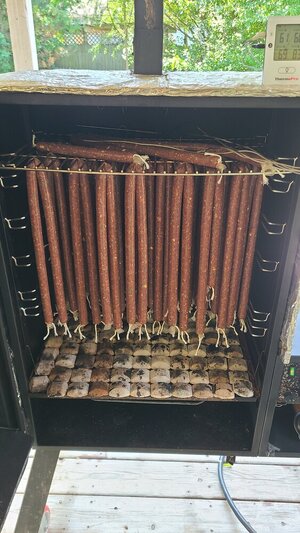- Dec 7, 2015
- 82
- 54
Have you considered using something like a cast iron griddle on the element, with wood chips for smoke generation? That would eliminate the condensation issue you have, and it could be removed as soon as the unit cools down.
Thank you for the kind words! There will still be a lot of tweaking as it's not 100% perfect. Such as still trying to get my magnets to stay on my wrap......
I have considered this, but.......... I originally went with the external smoke generation for the utmost control. Originally on my MES smoker, this setup worked perfectly with few issues, hence why I went this direction.
The reason for the external wood chips was due to the PID controller only fluttering the element, especially when all variables were minimal for heat loss. So happened was that the original chip pan wouldn't get hot enough to start the burning process in the chips. Basically was left with almost charcoal with no smoke to speak of.
I prefer the external also as I can start/stop the chips on the fly without having to open up the unit.
Now, will this happen on this setup? Not sure. I could try and and mod my element support in order to hold a chip tray to take the weight. As it stands, it's just enough to hold it up.
The position of my smoke generator I believe is part of the problem too. I mounted it at the end of the element and there is a gap from the end of the element to the edge of the cabinet. My thinking is that I am getting a down draft in this spot causing a backdraft of air and moisture into the smoke generator. The last build, it was under a hotter spot and my thinking is this also helped get more natural updraft through the generator to sustain smoking and keep moisture from getting into the generator.
So, my first goal is to MOD the generator....
1.) Going to add more lower holes to help aid in air flow through it.
2.) Originally used the same soldering iron as the last on, which is 45 watts and 750* max temp. To overcome the new found humidity levels with this unit, I am going to try and us a higher wattage, 900* soldering iron, or....I think as it will be cheaper, I am going to find a larger wattage cartridge heater to overcome my problems to get a better burn. The one I listed is 100 watts. But I need to look at max temps, etc... before deciding on trying one.






